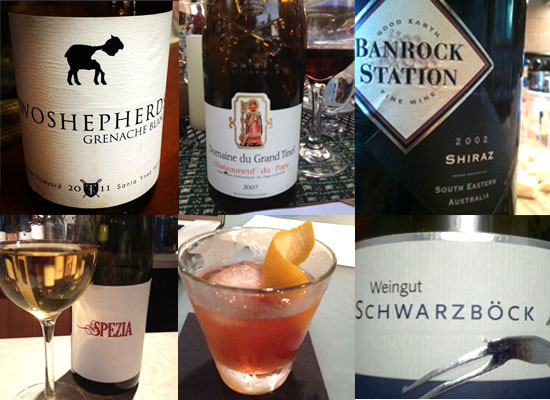What We Drank: July 10, 2012
What We Drank, the series within which we highlight interesting, often non-local libations that find themselves in our glasses, is back after a too-long hiatus.
Lenn Thompson: Two Shepherds 2011 Saarloos Vineyards Grenache Blanc
Tasting (and drinking) so much New York wine, it’s not every day that I get to taste grenache blanc. It’s even more rare that I get to taste one from California, made by a blogger-turned-winemaker.
A few weeks ago, William Allen, the Bermuda native behind Simple Hedonisms and Two Shepherds, visited Long Island wine country and asked me for my recommendations on where he should taste, eat, etc. As a thank you, he was gracious enough to leave some of his wines behind for me — and I couldn’t resist popping the cork on this one the next day.
When I read 14.1% abv on the label, I was expecting heft and oak. Luckily, my expectations were dashed quickly. It’s very well balanced, with citrus peel, green apple, subtle leesy notes and a distinct mineral note as well as well-integrated, almost-juicy acidity. Fermented with ambient yeasts in neutral oak, the mouthfeel is supple, succulent and and bright all at the same time.
The next day I Tweeted William to find out how I could procure more.
Evan Dawson: Domaine du Grand Tinel 2007 Chateauneuf du Pape
What kind of markup do you expect to pay in restaurants? Cheaper bottles tend to get marked up dramatically, but more expensive bottles should see a smaller markup percentage. For example, if a $15 bottle sells for $35, you wouldn’t expect a $100 bottle to sell for $235, but rather something more like $150.
That’s an ideal world, of course, but often restaurants do a dreadful job of setting prices for higher end bottles. I’ve had many general managers tell me that higher end botltes just don’t sell; then I see the wine list and a bad vintage, mediocre producer is going for an outrageous price. Of course it doesn’t sell.
So when I saw this wine on a restaurant list on Saturday night for $60, I felt compelled to try it. It retails for closer to $40, but keep in mind two things: first, Chateauneuf is a prestige name and often results in unreasonable markups, and second, this is from the most hyped vintage ever. I typically don’t dig 2007 CdP; too ripe, too hot, too big.
Not this wine, happily. Listed at 14.5 ABV, I’m inclined to believe it, and while it was big enough for a steak, it was multi-dimensional. Very nice array of savory and sweet, without ever pushing too hard in one direction. Most of all, this represents the rare good value on a restaurant wine list, as most of its ilk retails for more than what we paid in the restaurant.
Todd Trzaskos: Banrock Station 2002 Shiraz (Original price $9 1.5L)
From the “Budget Basement Cellaring Project,” where I’m testing the theory that inexpensive, well made, and well chosen wines, may age more gracefully than should be expected.Minor loss of edge color going brick red for a thin band, and then into a fine light red/purple hue. I don’t recall that this was a particularly tannic wine, but I do remember good fruit and balance. This one made it into the project because it was a utility wine which had been meant for a party and forgotten for some time before it was included.Highly pleasing aromatic medley of fresh red fruit jams. Strawberry, raspberry, cherry, with a slightly darker black currant note. Actually reminded a couple of us of lighter California zinfandel.Bright fruit attack of the aforementioned flavors, moves to a light mid-palate, with fine-grained astringency at the finish being the only hint of wood, and cassis into the horizon. The tastiness and lightness belie the 14% abv.
Paired delightfully well with traditional Sunday dinner at my folks place (with extended family seating 22). Dad’s meatballs, eggplant parmagiana, pasta, sautéed beet greens, and a fresh garden salad
This wine was suggested for consumption within 12 months of release. In this case, we were all glad to have waited.
Tracy Weiss: Anthony Nappa Wines 2010 “Spezia” Gewurztraminer
Anthony Nappa’s Spezia is some weird stuff.
The wine maker is best known for his popular, Anomaly, a favorite on the North Fork and in Manhattan. I’d heard rumors about his Gewürztraminer whispered around Peconic Bay like the legend of Harry Potter. You’ve got to try the ‘wine that almost wasn’t,’ they urged.The grapes used for this vintage were originally sold to another! They came down with a nasty case of the botrytis. Anthony swooped in the dead of night and rescued these late harvest orbs and walked them barefoot up hill in the snow and sang them lullabies until they dried out. Despite the hyperbole, and luckily for all of us, this gewürztraminer was born. Because it’s awesome.
The nose is a heavily perfumed tropical bouquet of hothouse blooms, the kind you’d find in the lobby of a fabulous Bora Bora resort. Gewürztraminers are known for their floral aromas but the Spezia blew my hair back in the best possible way.
I tasted stone fruit, concentrated pineapple, mango and a funk that was interesting and enjoyable. It goes down hot hot hot, but stayed well balanced with acid. It would be a perfect addition to the wine list at Harold Dieterle’s Kin Shop. Maybe I’ll smuggle a bottle in.
Julia Burke: Saz-That-Rac at the bar, Mike A @ Lafayette Hotel
My current favorite watering hole, located only a few blocks from my new place downtown, is Buffalo celebrity chef Mike Andrzejewski’s steakhouse at the newly renovated Lafayette Hotel.
Bar Manager Tony Rials, a sommelier by training but a genius with mixology, is in charge of the bar’s cocktail program, and his original list contains some of the most interesting and creative drinks in the city. Tony likes to use techniques such as infused sprays, dehydrating and rehydrating ingredients with spirits, and fat washing to lend his cocktails multiple levels of complexity, and my favorite of his drinks, a take on the New Orleans classic Sazerac (he calls his “Saz-That-Rac”), shows off this attention to detail.
Lavender-absinthe spray gives just a subtle floral menthol note, while flower honey and cognac add sweetness; rye and just a touch of Peychaud’s bitters complete the drink.
It’s slinky, sexy, and incredibly refreshing for summer, and while I know I should get around to trying every single one of Tony’s magnificent creations, I can’t seem to take my sights off this one.
David Flaherty: Weingut Schwarzböck, 2011 Trocken Riesling
Usually at this time of year, I find myself in a baby pool of riesling. I sit my little tub of liquid joy on my stoop in Queens with my swim trunks on and just sip its deliciousness, praying the humidity will rescind.
With the onslaught of the Summer of Riesling barreling through our organization, I get to try many, many rieslings. The joy and expressiveness is endless. This little beauty from Weingut Schwarzböck — a producer I’ve never tried before — comes from Lower Austria, clocks in as a “Trocken” (meaning it is fermented dry), and registers at 12.5% abv.
As I sit there in my pool watching the neighborhood kids mock me for being a “full grown man in a baby’s bath,” I just laugh. The jokes on them. While they’re overheating, I am on a palate journey that is rife with refreshing acidity, teeming with minerality, and all held together with a structure that is endlessly fascinating to ponder.
Laugh all you want, you little monsters, Daddy is in vinous bliss and he is cool, cool, cool.








Love the “Budget Basement Cellaring Project” concept. Keep that coming!
Glad you liked…comes from high aspirations, humble beginnings, and hope.
The outcomes have been decidedly in favor, some ‘meh’, and only a couple that degraded. Mostly Chilean and Portuguese wines in there now, and time to plug some more in. Cost at risk is very low, returns are enjoyable, and at the very least educational.
Tracy
I had the nappa gewurtz a couple of months ago and found it really interesting. There was tons of botyrised notes on the palate and really strong alcasian aromas. The thing that I found to be a bit off putting about this wine was the aromas of hops on the nose. It reminded me of a hopped heffeweisen. Thought this might be caused by extended skin contact like over a day atleast. Also, the orange-ish color was also a hint. Do you have any idea about the period of time this spent on skins? Really cool wine though.
Thank you Tracy for the writeup, I love your writing style you tell a great story, but hyperbole aside I can tell the real story…
The fruit is from Rilley’s vineyard in Cutchogue, it was contracted for and whomever contracted backed out as the fruit was rotten, I purchase other fruit from Joe and after we had harvested our reds Joe mentioned to me he still had Gewurtz hanging, “what?” so I had to check it out. Completely rotten fruit but the Bot had gone mostly ‘noble’ so I said I would take it!, He wanted to pick right away but I said “lets wait, whats going to happen its already rotten fruit”.
We picked a few weeks later under threat of weather and at that point I was hoping to make a late harvest dessert wine.
To answer Kris, I did not do any skin contact, you cant with rotten fruit or the “contact” you get is with rotten flavors, also I obviously did a lot of cleaning up but the risk of sour rot and vinegar bacteria among many other types of bacteria is too high to let things sit around in “contact”. I wanted to preserve Botrytis flavor, but not at the risk of moldy flavors or other bacterial spoilage.
So long story short the sugar was not high enough for a true dessert wine and I didn’t want to add anything so I figured I would let it ferment till it was happy and what residual remained hopefully is good, but it did not want to stop and fermented very cold over many months in the winter outside until it was dry.
For flavor it obviously has classic Gewurtz aroma, as well as herbal and tropical fruit as mentioned above, but it also has distinct dessert wine/noble rot flavors of honey/wax and dried apricot etc.
The hoppy thing is distinct and interesting, no idea where it comes from or why, but I love it,
And of note and interest is the wine has a mouth-feel and viscosity that is amazing.
Anyway thank you everyone for the interest and this wine is almost gone so make sure to grab up some as it is tasting better now then it ever has. As well as based on the conditions and situation making this wine possible, which I described above, it most likely will never be made again
Kris,
See, I kinda like that hoppy/herbal edge to the wine. I will find out about the skin contact or ask Anthony to chime in here.
This is a gewurzt-lovers gewurzt to be sure. I happen to love this wine.
LT
Really appreciate you taking the time to tell us about this wine really cool story.
Thanks
Tracy & Anthony